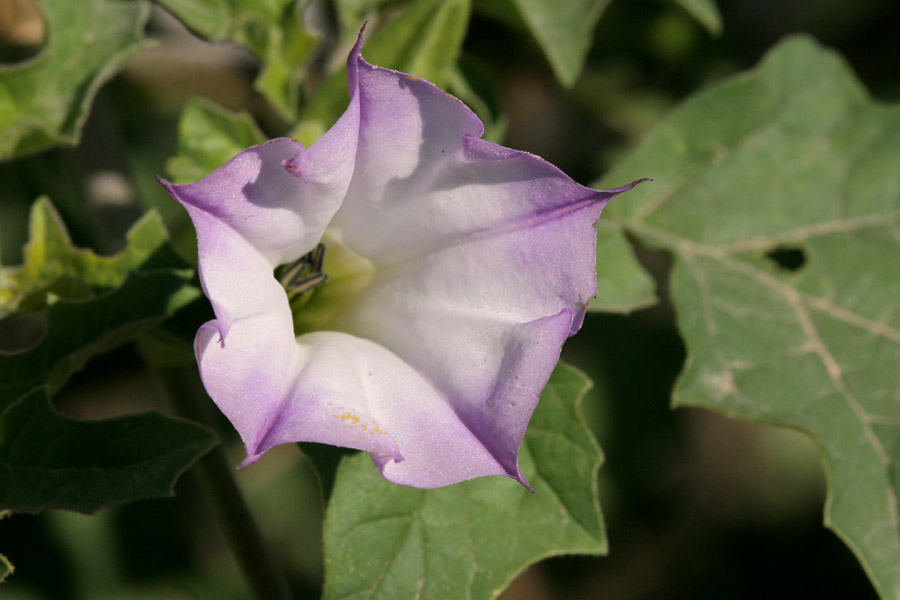|
Datura Ferox
''Datura ferox'', commonly known as long spined thorn apple and fierce thornapple, as well as Angel's-trumpets, is a species of ''Datura''. Like all such species, every part of the plant contains deadly toxins that can kill animals (including humans) that ingest it. Its fruit, red-brown when ripe, has unusually long thorns or spikes. The species was first described in 1756 by Carl Linnaeus, Linnaeus. ''Ferox'' means "strongly fortified," referring to the fearsome-looking spines on the seed pod. The species was long thought to have originated in southeastern China, but recent work by Symon and Haegi has demonstrated that, like all other ''Datura'' species, it is in fact native to the Americas. The species is very close in morphology to ''Datura quercifolia'', of which it may constitute a subspecies.'Datura (Solanaceae) is a New World Genus' by D.E. Symon and L. Haegi in (page 197 of) ''Solanaceae III: Taxonomy Chemistry Evolution'', Editors J.G. Hawkes, R.N. Lester, M. Nee & N. Est ... [...More Info...] [...Related Items...] OR: [Wikipedia] [Google] [Baidu] |
Carl Linnaeus
Carl Linnaeus (; 23 May 1707 – 10 January 1778), also known after his ennoblement in 1761 as Carl von Linné Blunt (2004), p. 171. (), was a Swedish botanist, zoologist, taxonomist, and physician who formalised binomial nomenclature, the modern system of naming organisms. He is known as the "father of modern taxonomy". Many of his writings were in Latin; his name is rendered in Latin as and, after his 1761 ennoblement, as . Linnaeus was born in Råshult, the countryside of Småland, in southern Sweden. He received most of his higher education at Uppsala University and began giving lectures in botany there in 1730. He lived abroad between 1735 and 1738, where he studied and also published the first edition of his ' in the Netherlands. He then returned to Sweden where he became professor of medicine and botany at Uppsala. In the 1740s, he was sent on several journeys through Sweden to find and classify plants and animals. In the 1750s and 1760s, he continued to collect an ... [...More Info...] [...Related Items...] OR: [Wikipedia] [Google] [Baidu] |
Datura
''Datura'' is a genus of nine species of highly poisonous, vespertine-flowering plants belonging to the nightshade family Solanaceae. They are commonly known as thornapples or jimsonweeds, but are also known as devil's trumpets (not to be confused with angel's trumpets, which are placed in the closely related genus ''Brugmansia''). Other English common names include moonflower, devil's weed, and hell's bells. All species of ''Datura'' are extremely poisonous and potentially psychoactive, especially their seeds and flowers, which can cause respiratory depression, arrhythmias, fever, delirium, hallucinations, anticholinergic syndrome, psychosis, and even death if taken internally. Due to their effects and symptoms, they have occasionally been used not only as poisons, but also as hallucinogens by various groups throughout history. Traditionally, psychoactive administration of ''Datura'' species has often been associated with witchcraft and sorcery or similar practices in man ... [...More Info...] [...Related Items...] OR: [Wikipedia] [Google] [Baidu] |
Datura Quercifolia
''Datura quercifolia'', commonly known as the oak-leaved thorn-apple, is a small shrub in the genus ''Datura'' that is native to Mexico and the Southwestern United States. It grows equally well in dry and moist soils and requires full sun. It contains a mix of alkaloids that are poisonous and can be potentially lethal when ingested. Description The species was first described in 1818 by Alexander von Humboldt Friedrich Wilhelm Heinrich Alexander von Humboldt (14 September 17696 May 1859) was a German polymath, geographer, naturalist, explorer, and proponent of Romantic philosophy and science. He was the younger brother of the Prussian minister, p .... Its green leaves resemble oak leaves, hence the name ''quercifolia''. It can assume both a prostrate and an upright bushy habit, with bushier forms reaching up to 3 ft. in height. It produces green seed capsules armed with long sharp spines, which, like those of some ''Datura'' species, open by four equal valves. The ... [...More Info...] [...Related Items...] OR: [Wikipedia] [Google] [Baidu] |
Tropane Alkaloids
Tropane alkaloids are a class of bicyclic .2.1alkaloids and secondary metabolites that contain a tropane ring in their chemical structure. Tropane alkaloids occur naturally in many members of the plant family Solanaceae. Certain tropane alkaloids such as cocaine and scopolamine are notorious for their psychoactive effects, related usage and cultural associations. Particular tropane alkaloids such as these have pharmacological properties and can act as anticholinergics or stimulants. Classification Anticholinergics Anticholinergic drugs and deliriants: * Atropine, racemic hyoscyamine, from the deadly nightshade ('' Atropa belladonna'') * Hyoscyamine, the ''levo''- isomer of atropine, from henbane (''Hyoscyamus niger''), mandrake (''Mandragora officinarum'') and the sorcerers' tree (''Latua pubiflora''). * Scopolamine, from henbane and '' Datura'' species (Jimson weed) All three acetylcholine-inhibiting chemicals can also be found in the leaves, stems, and flowers in v ... [...More Info...] [...Related Items...] OR: [Wikipedia] [Google] [Baidu] |


